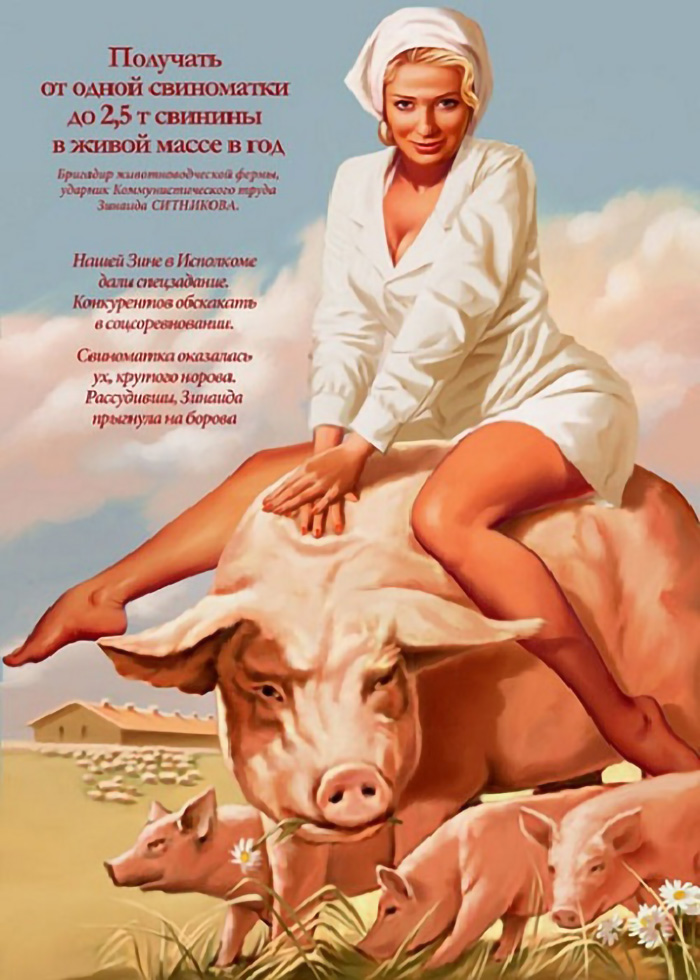
Pin-up is a genre that originated in America in the 1930s and immediately became very popular. Calendars and posters with pretty girls, drawn frivolously enough, but without excessive vulgarity, by the will of the artist often getting into various racy situations, hung at every bachelor, and during the Second World War, the American command even ordered pin-up pictures to raise the morale of its soldiers. In the previous article we found out the main features and secrets of popularity of American pin-up, told about the main masters who create in this genre. In this article we will talk about Russian artists who paint in this style.
Soviet pin-up by Valery Barykin.
Of course, in Soviet times pin-ups were banned, playful drawings were seen as an evil influence of the West, and no one even thought of drawing pin-up pictures, at least officially. Although it is possible that artists still created them for private orders - many well-to-do bachelors working on hard shift work somewhere in the north would like to have such a poster - both to show off to their comrades and to be pleasing to the eye.
Soviet pin-up by Valery Barykin.
In 1990-zero pin-ups began to be drawn in our country, but the home-grown pin-ups were certainly far from the level of Gil Elvgren. Their drawings shamelessly exploited women's sexuality without a proper sense of proportion and tact, and no one cared about any fresh ideas, just redrew existing posters and calendars, sometimes adding beauties to our Russian reality, although they looked completely alien there.
Soviet pin-up by Valery Barykin.
In the noughties there were several artists specializing in pin-up, such as Valery Barykin. And here he managed to combine the incompatible, to cross a bulldog with a rhinoceros - that is, the Soviet propaganda poster and pin-up. The result was somewhat peculiar, but interesting and certainly unusual. And if we remember that pin-ups were actively used for advertising and boosting the morale of American soldiers, then the objectives of posters and pin-ups were generally the same, even if they were achieved by different means of expression.
Soviet pin-up by Valery Barykin.
Barykin has managed to find his style, which may not appeal to everyone, but he has enough fans. The main thing here is an interesting idea, which Barykin realized to the best of his creative abilities.

Soviet pin-up by Valery Barykin.
Barykin graduated from college as a theater artist and started working in an advertising agency, where he received an order to advertise a calendar for a construction company. Logically reasoning that the main audience - men, Barykin decided to make a calendar for them in the style of pin-up, but taking into account the Soviet realities. The result was unusual and fresh, nothing like it had ever been done before.
Soviet pin-up by Valery Barykin.
The calendar sold out in good numbers, and Barykin's drawings were noticed and copied by everyone. Venerable artists said that they could have drawn better, but Barykin himself states unequivocally that the idea did not come to them, so he collects the cream.

Soviet pin-up by Valery Barykin.
Barykin's artworks often cause a nostalgia attack for many people who lived in the Soviet times, when everything negative has already been forgotten, and there are only pleasant memories that the grass used to be thicker and bushes greener. He willingly uses all the symbols of the Soviet era - cars, movies, foodstuffs, his characters are dressed as they were dressed then, although the girls dress in more frivolous outfits and willingly expose their shapely legs.
Soviet pin-up by Valery Barykin.
The girls in Barykin's pictures invariably find themselves in the center of attention, they shamelessly use their attractiveness and are clearly looking for adventures on their second 90. They are no longer models with the innocent faces of 15-year-old girls, as in the pin-up by Gil Elvgren, but real seductresses who are used to male attention and take it for granted.
Soviet pin-up by Valery Barykin.
Barykin's pin-ups are more straightforward, fantasy and mystery have disappeared, characters' emotions are far-fetched and unnatural, but his artwork, thanks to his fresh approach and nostalgia for the USSR, is in good demand, and Barykin is happy to make them in industrial quantities, logically reasoning that an advertiser should sell his pictures as long as there is demand for them.
Buy handmade goods or modern art you can on artAlebrio - is an international marketplace for people who want to create, sell, buy and collect unique items and art - buy the best with us artAlebrio.com.
By confirming your order you unconditionally accept these General Conditions of Sale